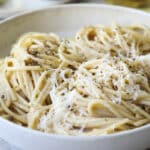
Spaghetti Cacio e Pepe
Classic Cacio e Pepe is a three-ingredient miracle made with pasta, Pecorino Romano, and black pepper. Learn my secret to achieving a silky, restaurant-worthy sauce each and every time.
Servings 4 servings
Calories 259kcal
Ingredients
- Salt and freshly ground black pepper coursely ground (see note 1)
- 8 ounces spaghetti (see note 2)
- 1/2 cup Pecorino Romano cheese freshly grated, about 2 ounces (see note 3)
Instructions
- Bring a large pot of water and 1 tablespoon of salt to a boil. Add spaghetti and cook until 2 to 3 minutes before indicated al dente time, about 8 minutes.
- While the pasta is cooking, in a large skillet over medium to medium-high heat, add 1/4 teaspoon fresh coarsely ground black pepper. Cook until pepper is fragrant and begins to toast, about 30 seconds to 1 minute.
- Add a ladle of pasta water (about 4 to 6 ounces) to the skillet with the pepper. Reduce heat and simmer.
- Using tongs, transfer pasta from the pot to the skillet, reserving pasta water. Toss with pepper mixture until pasta is al dente, about 2 to 3 minutes, adding more pasta water if pan becomes dry.
- In a small bowl, combine Pecorino with enough pasta water to form a thick paste. Add Pecorino paste to pasta and use tongs to combine.
- Continue to toss pasta until sauce is creamy and thick, adding more pasta water if needed. Serve with additional grated Pecorino cheese and pepper.
Video
Notes
- Black Pepper: Coarsely ground pepper is best for this dish. Freshly grind whole black peppercorns using a pepper mill, mortar and pestle, or crush using a meat tenderizer. If you only have finely ground on hand. Use less and adjust to taste.
- Spaghetti: Or any long-cut pasta, such as the traditional pici, or bucatini, tonnarelli, linguine, or fettuccine.
- Pecorino cheese: Ideally, start with a block of Pecorino and use a box grater or pulse in a food processor to shred it yourself. Pre-shredded or pre-grated cheese can contain ingredients that prevent the cheese from melting as smoothly as it does fresh from the brick.
- Butter: While not traditional in this Roman dish, many enjoy the added taste of butter. Melt 1 tablespoon butter in the skillet before adding pepper in step 2. Add an additional tablespoon in step 6 along with the pasta.
- Yield: This recipe makes about 4 cups of pasta, enough for 4 servings, 1 cup each.
- Storage: This dish is best enjoyed the day it is made, but leftovers can be stored covered in an airtight container in the refrigerator for up to 4 days. Reheat in the microwave with a splash of water.
Nutrition
Serving: 1 cup | Calories: 259kcal | Carbohydrates: 43g | Protein: 11g | Fat: 4g | Saturated Fat: 2g | Polyunsaturated Fat: 0.4g | Monounsaturated Fat: 1g | Cholesterol: 13mg | Sodium: 153mg | Potassium: 137mg | Fiber: 2g | Sugar: 2g | Vitamin A: 52IU | Calcium: 145mg | Iron: 1mg